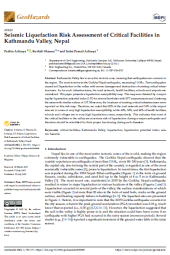Seismic Liquefaction Risk Assessment of Critical Facilities in Kathmandu Valley, Nepal
Summary
Kathmandu Valley, situated in an active tectonic zone, experiences frequent earthquakes. The recent Gorkha Nepal earthquake of magnitude 7.8 Mw highlighted soil liquefaction risks, causing significant damage to vital infrastructures.
This paper introduces a liquefaction susceptibility map, achieved by calculating the liquefaction potential index (LPI) using SPT measurements from boreholes and clustering areas with similar LPI values. Critical infrastructures such as roads, health facilities, schools, and airports were marked on this risk map. Notably, 42% of roads and 16% of airport areas face very high liquefaction susceptibility. Similarly, 60% of health facilities, 54% of schools, and 64% of colleges are in high liquefaction zones. This underscores the urgent need to retrofit these critical structures to ensure their functionality during major earthquakes.
Categories:
Research Paper
Writer:
Prabin Acharya, Keshab Sharma, andIndra Prasad Acharya
Link Source:
https://doi.org/10.3390/geohazards2030009
Published Year:
2021
